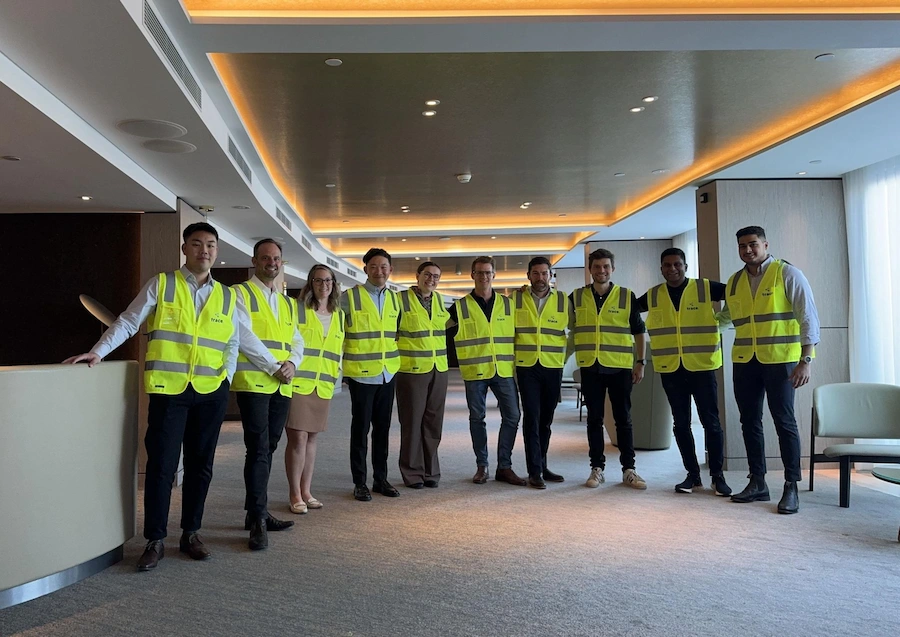Ready to turn insight into action?
We help organisations transform ideas into measurable results with strategies that work in the real world. Let’s talk about how we can solve your most complex supply chain challenges.

In today’s dynamic and complex business environment, supply chain management is more critical than ever. Organisations must continually adapt to changing market conditions, customer expectations, and operational challenges. To remain competitive and ensure efficiency, businesses often undertake large-scale supply chain projects that require expert knowledge, advanced technologies, and strategic insights. These projects range from network optimisation and procurement reviews to sustainability initiatives and digital transformations.
While some companies have the internal expertise to manage these projects, many turn to supply chain consultants to bring specialised skills, industry experience, and objective insights. Consultants can provide valuable guidance throughout the project lifecycle, ensuring that initiatives are executed successfully and deliver the desired outcomes.
In this article, we explore the key supply chain projects that often prompt organisations to engage supply chain consultants and explain how these experts can help drive efficiency, cost savings, and operational excellence.
1. Supply Chain Network Optimisation Projects
One of the most common reasons organisations engage supply chain consultants is to optimise their supply chain network. Network optimisation involves designing an efficient configuration of facilities, distribution centers, warehouses, and transportation routes to minimise costs and improve service levels. As companies grow, expand into new markets, or face changing customer demands, their existing network may no longer be effective.
Challenges that prompt network optimisation include:
- Rising Transportation Costs: Increasing fuel costs, longer delivery times, and underutilised vehicles can make transportation a significant expense.
- Customer Expectations for Faster Delivery: The demand for same-day or next-day delivery requires businesses to reevaluate their warehouse locations and distribution strategies.
- Inefficient Warehouse Utilisation: Outdated or poorly located warehouses may lead to high inventory carrying costs and inefficient operations.
How Consultants Help:
- Optimising Warehouse Locations: Consultants use advanced network optimisation tools to determine the ideal number and location of warehouses to balance cost and service level goals.
- Reducing Transportation Costs: Consultants analyse transportation routes, identify cost-saving opportunities, and implement solutions like route optimisation and load consolidation to reduce freight expenses.
- Improving Service Levels: By reconfiguring distribution networks, consultants help businesses shorten lead times and meet customer expectations for faster deliveries.
2. Procurement and Spend Optimisation Projects
Procurement and spend optimisation projects focus on improving how businesses manage their suppliers, contracts, and purchasing decisions to reduce costs and improve supplier performance. Supply chain consultants are often brought in to review existing procurement strategies, negotiate better terms with suppliers, and identify opportunities for cost savings.
Challenges that prompt procurement optimisation include:
- Supplier Over-Reliance: Over-dependence on a small number of suppliers increases risk, especially if a supplier experiences delays or quality issues.
- High Procurement Costs: Inefficiencies in the procurement process, such as poor contract management or a lack of competitive bidding, can lead to higher costs.
- Compliance and Risk Management: Growing regulatory pressures, such as modern slavery laws or environmental regulations, require businesses to closely monitor their supplier relationships and ensure compliance.
How Consultants Help:
- Supplier Risk Assessment: Consultants assess supplier performance and help diversify the supplier base to reduce reliance on a few key providers.
- Negotiating Better Terms: Consultants leverage their market knowledge to negotiate more favourable contract terms, leading to lower prices and improved supplier relationships.
- Implementing Spend Analytics: Using advanced spend analytics tools, consultants identify inefficiencies, analyse purchasing patterns, and recommend strategies to optimise spend across categories.
3. Digital Transformation and Technology Implementation Projects
The digital transformation of supply chains is a major trend across industries, as businesses seek to integrate advanced technologies to improve efficiency, visibility, and decision-making. Digital transformation projects often involve the implementation of new software solutions, such as enterprise resource planning (ERP) systems, transportation management systems (TMS), or warehouse management systems (WMS).
Challenges that prompt digital transformation include:
- Lack of Visibility: Limited visibility across the supply chain can lead to delays, inefficiencies, and poor decision-making.
- Manual Processes: Many supply chains still rely on manual data entry or paper-based processes, which slow down operations and increase the risk of errors.
- Data Silos: Disconnected systems across different departments prevent the free flow of information, making it difficult to get a holistic view of the supply chain.
How Consultants Help:
- Technology Selection: Consultants help businesses identify the right technologies for their needs, ensuring that systems are scalable, integrate well with existing platforms, and provide real-time data visibility.
- Implementation Support: Consultants guide businesses through the implementation process, from software installation to employee training, ensuring a smooth transition to the new system.
- Process Automation: Consultants identify opportunities for automation across the supply chain, such as automating order processing, inventory tracking, or demand forecasting, leading to improved efficiency and reduced costs.
4. Sustainability and Carbon Reduction Projects
Sustainability is becoming a key focus for many organisations, driven by consumer demand, regulatory pressures, and corporate responsibility goals. Supply chain sustainability projects aim to reduce carbon emissions, minimise waste, and create more environmentally friendly operations. However, balancing sustainability initiatives with cost control and efficiency can be challenging, prompting businesses to seek expert guidance.
Challenges that prompt sustainability projects include:
- Regulatory Compliance: Governments around the world are implementing stricter regulations on emissions, waste management, and ethical sourcing, requiring businesses to rethink their supply chain practices.
- Rising Consumer Expectations: Consumers are increasingly demanding eco-friendly products and sustainable business practices, putting pressure on companies to improve their environmental performance.
- Cost of Sustainability Initiatives: Implementing sustainability practices, such as transitioning to electric vehicles or adopting circular economy principles, can be costly without the right strategy.
How Consultants Help:
- Carbon Footprint Reduction: Consultants conduct sustainability audits to assess current carbon emissions and identify areas where emissions can be reduced through energy-efficient practices, transportation optimisation, or renewable energy adoption.
- Sustainable Sourcing: Consultants help businesses develop sustainable sourcing strategies, working with suppliers to ensure compliance with environmental and ethical standards.
- Circular Economy Implementation: Consultants assist businesses in adopting circular economy principles, such as reducing waste, recycling materials, and designing products for reuse or remanufacture, which can lead to long-term cost savings.
5. Mergers and Acquisitions (M&A) Supply Chain Integration Projects
Mergers and acquisitions can create significant challenges for supply chain management, as organisations must integrate new systems, processes, and supply chain networks. Supply chain consultants are often engaged to ensure a seamless transition during M&A activities, helping businesses consolidate operations, reduce costs, and optimise the newly formed supply chain.
Challenges that prompt M&A supply chain integration include:
- System Integration: Integrating different supply chain management systems from the merging entities can be complex and time-consuming, particularly if they use different platforms.
- Operational Inefficiencies: Combining two supply chains can lead to redundancies, such as overlapping warehouse locations or excess inventory, which need to be addressed.
- Supplier and Contract Consolidation: M&A activities often involve merging supplier contracts and renegotiating terms to reflect the new organisation’s needs and scale.
How Consultants Help:
- Supply Chain Due Diligence: Before an acquisition, consultants conduct due diligence on the target company’s supply chain to identify risks, opportunities, and integration challenges.
- System Integration: Consultants manage the integration of supply chain systems, ensuring that the newly combined organisation can operate efficiently and that data flows seamlessly across platforms.
- Supplier and Contract Rationalisation: Consultants assist in consolidating supplier contracts, renegotiating terms, and eliminating redundancies to reduce costs and improve supplier performance.
6. Inventory Optimisation and Working Capital Management Projects
Managing inventory levels effectively is critical to maintaining supply chain efficiency while minimising costs. However, many organisations struggle with excess inventory, stockouts, and inefficient use of working capital. Inventory optimisation projects, often led by supply chain consultants, focus on improving inventory management processes, reducing holding costs, and ensuring that stock levels align with customer demand.
Challenges that prompt inventory optimisation include:
- Excess Inventory: Holding too much inventory leads to increased carrying costs and the risk of obsolescence, particularly for slow-moving products.
- Stockouts and Lost Sales: Poor inventory management can result in stockouts, leading to lost sales, dissatisfied customers, and the need for costly rush orders.
- Cash Flow Constraints: Tying up too much capital in inventory can limit a company’s ability to invest in other areas of the business, such as new product development or market expansion.
How Consultants Help:
- Inventory Analytics: Consultants use advanced analytics to assess current inventory levels, identify trends, and recommend strategies to optimise inventory management.
- Demand Forecasting: Consultants help businesses improve demand forecasting accuracy, ensuring that inventory levels align with real-time customer demand and reducing the risk of overstocking or stockouts.
- Working Capital Optimisation: By optimising inventory levels, consultants free up working capital, improving cash flow and enabling businesses to invest in growth opportunities.
The Role of Supply Chain Consultants in Delivering Successful Projects
Supply chain consultants bring specialised expertise, industry insights, and advanced tools to help businesses successfully manage complex supply chain projects. By working closely with internal teams, consultants ensure that projects are delivered on time, within budget, and aligned with the organisation’s strategic goals.
Here’s how consultants add value to supply chain projects:
- Objective Analysis: Consultants provide an unbiased perspective on supply chain performance, identifying inefficiencies, risks, and opportunities for improvement.
- Tailored Solutions: With a deep understanding of industry best practices, consultants develop customised solutions that address the specific challenges of each project.
- Project Management: Consultants manage the project lifecycle, from initial planning and strategy development to execution and post-project evaluation, ensuring that the project stays on track.
How Trace Consultants Can Help with Supply Chain Projects
At Trace Consultants, we specialise in supporting organisations through a wide range of supply chain projects, from network optimisation and procurement reviews to digital transformation and sustainability initiatives. Our team of experts brings the knowledge, tools, and experience needed to drive successful outcomes for your business.
We offer a comprehensive suite of services, including:
- Supply Chain Network Optimisation: We help businesses redesign their supply chain networks to reduce costs, improve service levels, and adapt to changing market conditions.
- Procurement and Spend Optimisation: Our consultants work with you to optimise your procurement strategies, negotiate better supplier contracts, and identify opportunities for cost savings.
- Digital Transformation: We guide businesses through the digital transformation process, helping implement the latest technologies to improve visibility, efficiency, and decision-making.
- Sustainability Initiatives: We provide expert guidance on sustainability projects, from reducing carbon emissions to implementing circular economy practices and meeting regulatory requirements.
By partnering with Trace Consultants, your organisation can tackle complex supply chain challenges with confidence, achieve operational excellence, and realise long-term value through successful project execution.
Ready to turn insight into action?
We help organisations transform ideas into measurable results with strategies that work in the real world. Let’s talk about how we can solve your most complex supply chain challenges.









